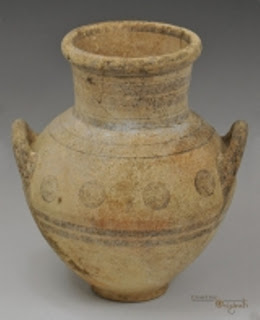Last week was a quiet and productive week. I thought I completed my research on the Cypro-Archaic pottery, but I was mistaken. During the week I had to write a general synopsis of ancient Cyprus: it included the social and political issues from the Middle Cypriot period (2500-1050 B.C.) to the Cypro-Archaic period (1050-325 A.D.). My research also included the art historical significance of the periods, as well as trade relations with other nations. For instance, Cyprus has a rich and diverse culture influenced by the Minoan and Mycenaean civilization, the Syro-Palestinian culture, the Hittites and the Egyptians. For centuries Cyprus traded goods and artistic craftsmanship with such neighbors.
The island was also famous for its cooper supply. By the Late Cypriot period (1650-1050) Cyprus was fully integrated into an exchange network connecting the Aegean, Egypt and Syria-Palestine. Sustained by wealth generated through the export of copper and the island's convenient juxtaposition between the Near East and Aegean, cities on Cyprus flourished. Cypriot potters were also artisans who exercised considerable imagination in their craft. Their wares were always interesting and often exuberant, even sometimes outlandish. Since pottery was produced in small batches by individuals or families rather than by factories, idiosyncrasy rather than uniformity was the rule. Pottery was also discernibly regionalized, varying from place to place on the island. This makes the Bronze Age pottery of Cyprus among the most diverse found anywhere in the ancient world.
I also need to include in my research how and why the National Hellenic Museum acquired on loan their antiquities from Cyprus. I know that the museum received the pottery on loan from the Cyprus government in 2001. There is a lot of paperwork I need to go through to understand why the loan was approved. I also plan on talking with the Collections Manager Chris. Perhaps he can shed some light on the matter.
Regards,
Erik
Reference:
The Censola Collection from Ancient Cyprus

